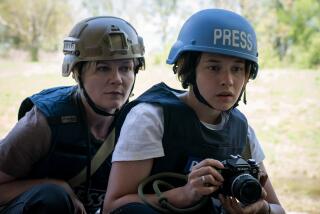An LAPD Crime Scene Photographer Views the City in a Grim Light
LOS ANGELES — While grief is still ripe in a crowded Koreatown neighborhood after a gang-related shooting, Bill Heimanson must attempt to reconstruct with his camera what happened.
Earlier, five youths were sitting on an apartment stoop, listening to tunes under a late Saturday afternoon sun. A teenager walked by, then turned toward the oldest of the group.
“Hey man, who you with?” he asked.
“Man,” the 17-year-old answered, “I ain’t in no gang.”
The pedestrian responded by squeezing several rounds from a semiautomatic handgun into all five kids, leaving them gasping for their lives as he ran away.
Two hours later, Heimanson, an LAPD Special Investigations Division photographer, aims his camera at a mosaic of spent bullet casings and bloodstains left on the stoop and shoots.
“You can tell from where most of this mess is, they tried to take refuge in their apartment,” he says matter-of-factly. For six years now, Heimanson has been weaving his way through TV news reporters and bystanders at the scene of a crime to provide police detectives with reliable visuals of how it all developed.
*
As with the rest of the department’s 25 photographers, Heimanson’s job requires that he get a shot of everything at the scene that might have contributed to a criminal act.
But because of the post-Simpson trial pressure the department faces to produce airtight cases, and the emotion some crimes evoke, it’s not as easy as just pressing a shutter button.
Photographing a crime scene often includes wading through a sea of stress. One botched photo, says Heimanson, could mean a contaminated case and a subsequent verbal lynching by the detectives.
And snapping shots of a mutilated body while friends and relatives grieve nearby or forcing a recently abused child to sit still while photographing her cigarette burns can be an emotional drain.
That is why after hundreds of crime scenes, photographers such as Heimanson learn to balance sensitivity with cynicism.
“I’ve been attacked before,” he boasts while snapping photos of gang graffiti scrawled on some walls across the street from the scene of the Koreatown shooting.
“One guy didn’t like me taking pictures of his ‘homey’ while he lay dead in the street.
“What are you gonna do? I had to get the shot.”
While he crouches in an apartment building flower bed to get a better view of the bloody stoop, a pregnant woman stares glumly at Heimanson through a nearby window.
Ignoring her, he shouts: “Detective? Where’s [bullet] No. 18?
“It’s sad,” Heimanson says later. “But I have to block those people from my mind. If you let them get to you, you wind up screaming on the floor at home.”
He watches horror movies when he goes home. “They relax me,” he says with a wry smile.
*
Having taken pictures since he was 15, the unmarried photographer obsesses on camera work, collecting antique cameras in his Studio City home and volunteering to take family photos for couples he knows.
Before photographing corpses and crime scenes for the LAPD, Heimanson freelanced for 10 years for health and fitness magazines.
“A body’s a body,” he shrugs.
He was shooting pictures for government defense contractors when he met a retired cop who, appreciating Heimanson’s dark sense of humor, suggested a career move.
“He said: ‘You’re a morbid creep. Why don’t you do crime scenes?’ ”
To prepare himself, Heimanson volunteered 100 hours as a corpse photographer for the county coroner’s office. “I needed to see if I can exist around dead bodies,” he said. “It turns out I met some pretty interesting people there. Some of them even had pulses.”
After being hired by the LAPD, Heimanson enrolled in a series of FBI detective seminars during his spare time in order to better understand what builds an effective case.
He sometimes offers insight to homicide detectives during crime scene shoots.
“If you have a novice detective, a good photographer can play a major part in an investigation,” said Lt. Anthony Alba, a former homicide detective. “They have good visual sense. They can see things like from which direction blood splatters or whether there are additional elements [such as graffiti] that a detective might have missed. All that is crucial when it comes to verifying a witness’ statements in court.”
It is the photos that often help jurors retain graphic memories of virtually every feature linked to a crime. Those images may eventually fade for jurors, but for police photographers they can be haunting reminders of the city’s criminal underbelly.
“We see more crime scenes than homicide detectives,” Heimanson said, “because we’re out on every one.
“If people in this city realized what was going on here every night, they’d get the hell out.”
More to Read
Sign up for Essential California
The most important California stories and recommendations in your inbox every morning.
You may occasionally receive promotional content from the Los Angeles Times.









